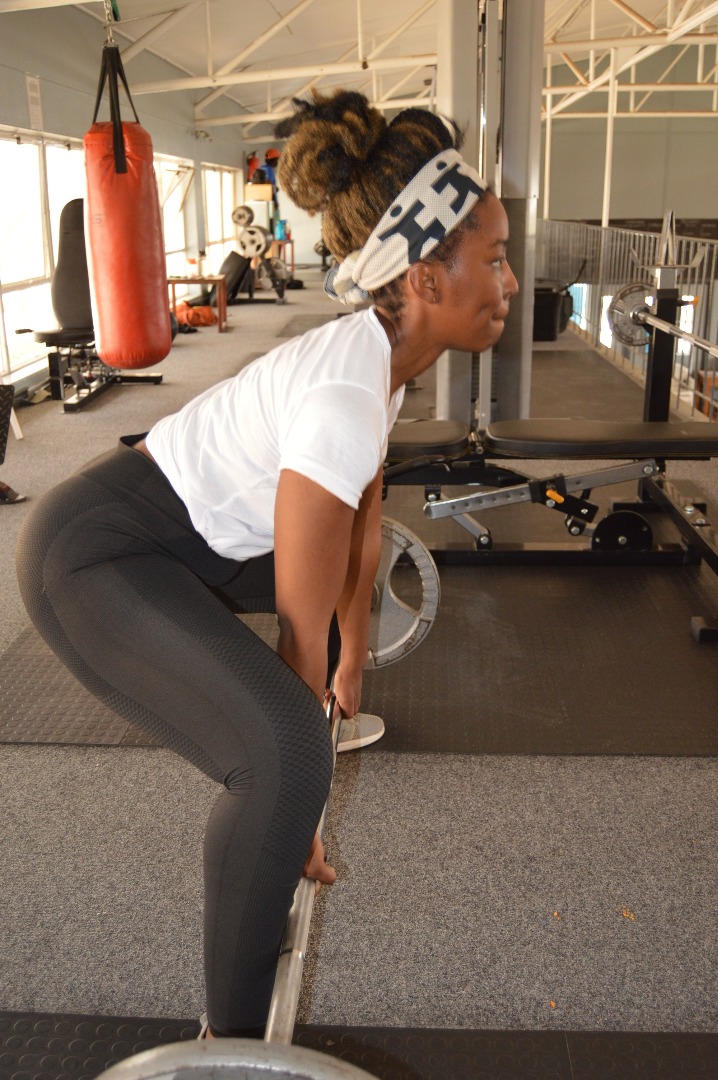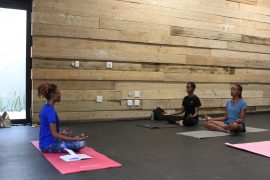The answer is, yes.
I often hear questions like:
What weight should I start with?
How much should I be lifting?
How do I know what weights I should be doing?
What exercises should I be doing if I want to grow sculpt my booty?
Okay, that last one was all me.
If you find yourself with a billion strength training questions, or you’re overwhelmed at all of this and not sure how to get stronger…then you’re in good company!
Bodyweight First
Stop! Let’s back it up a second.
Before even trying to figure out how much weight you can lift, make sure you know how to do the movement, as flawless as possible, without any weight at all.
Why?
Because if you can’t do a movement correctly without weight, how can you expect to do it right WITH weight? Think about it – if you can’t walk up a flight of stairs normally, would you expect to be able to walk up the flight of stairs carrying bags of groceries? No – you would probably only hurt yourself.
So, your first step should be to learn each movement without any bars, dumbbells, or any added weight.
“But!” you say, “how on earth do I do a deadlift or a press without any weight? And I know I can do a bodyweight squat, but isn’t it completely different with a bar on your back?”
Easy – grab either a broomstick (be careful for splinters!), mop handle, or PVC pipe and pretend it’s a bar. If you’re trying to mimic a dumbbell movement, grab two water bottles (with water), or just hold your hands in a fist as if you were holding on to something. Even though it is not exactly the same as holding actual weight, it will allow you to practice getting into the correct positions.
One great reason to start here is that you can do it in in the comfort of your own home. And once you feel good about your form, you can see if you can “pass the bar.”

Now, the bar.
Your first workout shouldn’t go any heavier than “just” the bar, which means the bar without any added weight. A standard barbell weighs about 20kg. Now, don’t be discouraged if this seems really heavy – especially on upper body movements. When I started out, I could not bench press or overhead press an empty barbell.
If the bar seems too heavy to start, you still have a few options:
Look to see if the gym has a lighter barbell, these are usually shorter, but that’s okay (just make sure it’s a straight bar.
You can also, start out with dumbbells – while the movement is not the exact same, it allows you to build up the strength to be able to correctly handle the bar. Focus on bodyweight training and incorporating moves like (pushups, pullups, lunges, squats) until you build up the strength to handle the bar.
Now, on opposite ends of the spectrum, if the bar seems really light, I would STILL encourage you to complete your first workout with just the bar. Focus on getting each rep correct, and worry about adding weight once you’ve mastered the empty bar. Check your ego at the door; I would rather see somebody in the gym lifting the bar with proper form than watch somebody with awful form lift 100 kgs. I cringe when I see that happen, which is far far too often.
If you’re not comfortable with the movement and you start adding weight, not only will you be more likely to injure yourself because your body isn’t ready, but you’ll be more likely to hurt yourself because you won’t be confident under the bar. Confidence is something that is very important as you start lifting heavier and heavier.
So, whether you’re starting with dumbbells or ready to move onto a barbell, it’s important to do it properly! The most common rep ranges for beginner programs are 5 sets of 5, 3 sets of 8, or 3 sets of 10.
Remember, no matter how heavy you are lifting, always start with just the bar or body weight to warm up for EACH exercise. This helps get your body warm, primes your nervous systems and all of your muscles for that movement, and gets you ready to lift heavier weight.
As a beginner, this is especially important to ingrain proper technique.
Next, you are not ready to add some weight to the bar. Depending on how heavy the bar felt, start by adding anywhere from 2.5 kgs to 5 kgs to each side. Do another set of 5 reps at this weight.
Continue to do this until your form starts to break down or the speed of the lift gets slower on any of your reps. The weight you used right before your form started to break down is your starting weight on which you will base all future workouts!
If it is a lower number than you expect, that would be the right number! Don’t try to be a hero during your first workout, it is better to start out too light than too heavy. Remember – we’re trying to get solid, productive sets in, not find our one rep max, so we want all of the reps to be fast and with as perfect form as our body allows.
Once you find your starting weight, you’ll want to start using something called “progressive overload.” This sounds a lot fancier than it really is. Simply put, progressive overload means gradually increasing the stress put on your body during training.
In other words, we need to increase something, regularly. Usually this means the amount of weight we lift. And for beginners, that can often happen in every workout. After every workout our body heals, and if you’re getting proper sleep and nutrition, it heals back stronger than it was before.
If you do 5 sets of 5 at 60 kgs for every single workout for months, are you getting stronger? Most likely not – your body is becoming more efficient at lifting 5×5 at 60 kgs, burning less calories and using less processes to make that movement happen.

So, how much weight do you add when you’re ready to increase your workouts?
That depends on how difficult the last sets of your last workout were. This is where great note-taking comes in (I’m a huge fan of a simple notebook, you should see mine). Be sure to document not only how much you lifted and for how many reps, but also how your lifts went so next time you know what you need to be doing.
Did you go to failure on your last set? Did your form break down on any of the reps?
If you failed to complete any of your reps or your form started to break down, it might not be a bad idea to do the same weight again, and focus boosting your form and technique of each rep.
Remember, if you are doing the same workout as last time, but each rep is more solid and with better form than before, you’re still doing better than you were last workout – you’re still leveling up. You don’t necessarily have to go up in weight every workout to see gains. Less rest between sets, more control and better form, and more repetitions all mean you are getting stronger.
The BEST THING YOU CAN DO is to slowly add weight and progress consistently rather than progress very quickly then hit a plateau. Each week, as you add a little bit of weight, you are building strength, confidence, and momentum.
Remember that there will be days when you can’t add any weight at all. So many things affect how your lifts are going to feel so, it is vital to listen to your body over listening to some number telling you what you should be lifting.
You should be lifting the amount that’s right for you today. In your next workout you should be trying to lift more (even if you can’t do more weight, try doing one more rep, or with less rest between sets) than you did last time. It’s amazing how much even adding just 2kg a week adds up to! It’s far better to play it safe in the beginning than to find yourself injured and frustrated before you have a chance to progress.
That’s it. As a part of this journey, I want you to completely forget about the strength standards you are bombarded with every time you open up your Instagram and forget about everyone around you. I don’t care if the guy or girl next to you is squatting 100 kgs for sets of 10. If you’re squatting 45 kgs, and that’s the weight that is challenging for you, then that’s the weight you should be lifting. Period.
Never try to outlift the person next to you. Never adjust the weight to impress someone. No one’s judging you based on the weight on the bar, and if they are, they aren’t worth your time or energy.

So, let’s sum it all up:
The best lifters I know warm up with “just” the bar.
The best lifters I know focus on getting their reps in, and aren’t ashamed that they’re lifting less than the person next to them.
The best lifters I know take time to get things right, even if that means lifting less weight than they know they “can” do.
The strongest lifters I know started off doing a beginners program just like you.
So remember – start slow, add weight slowly, and stay consistent.
For more workout inspiration check out my Instagram!




